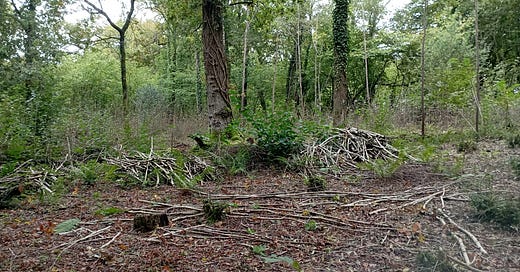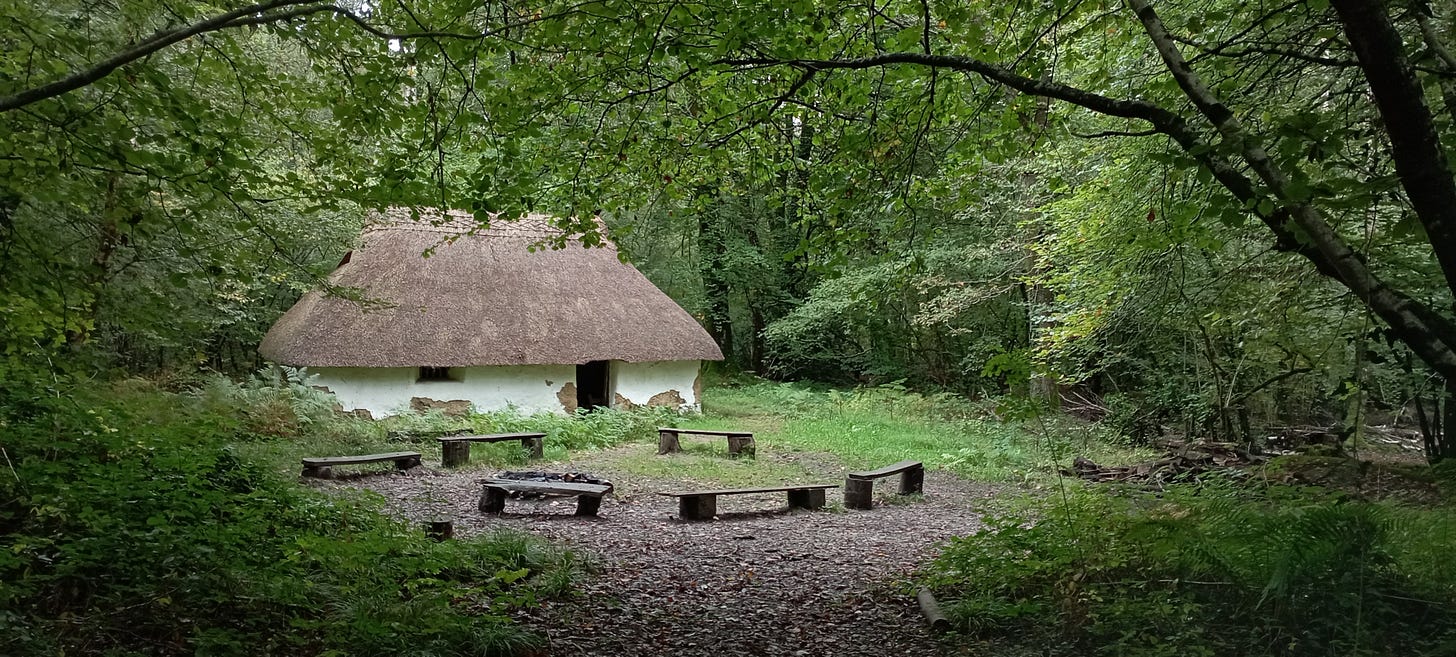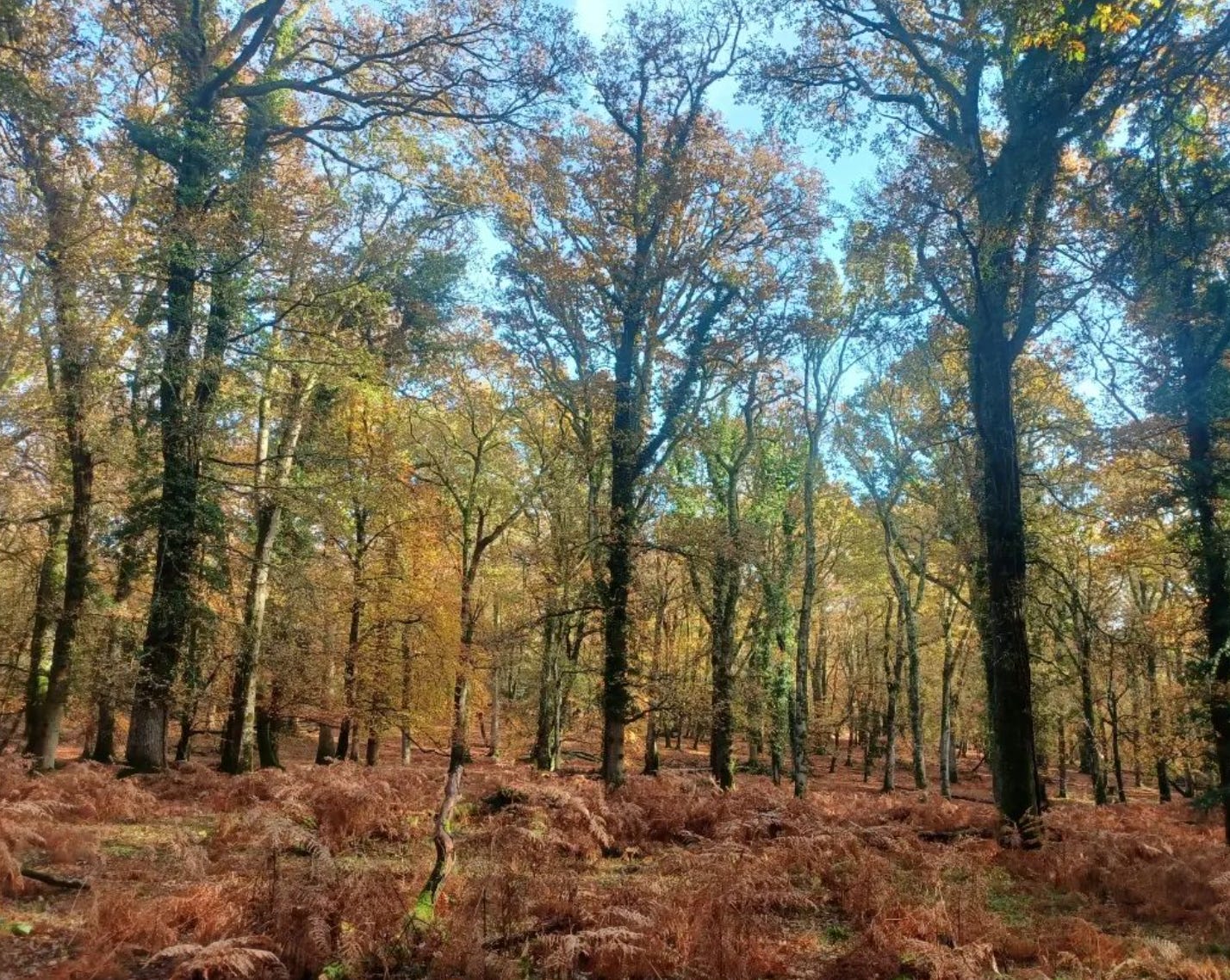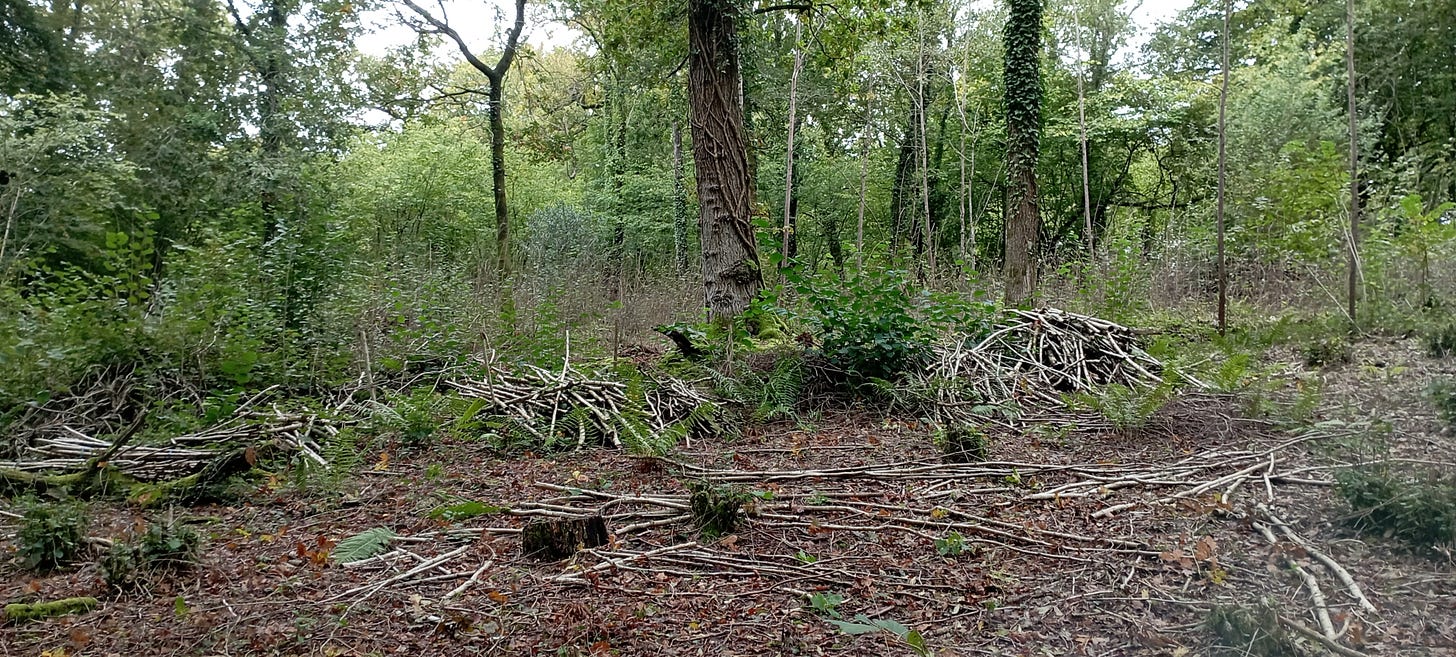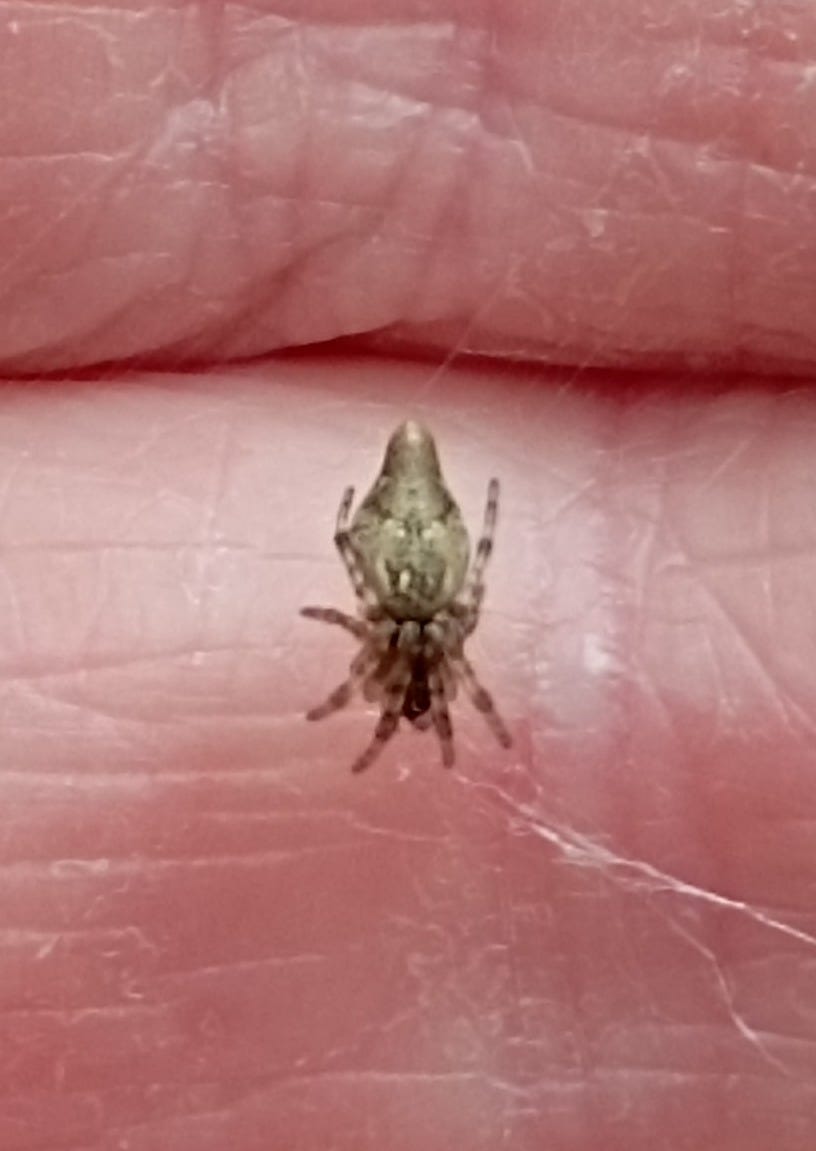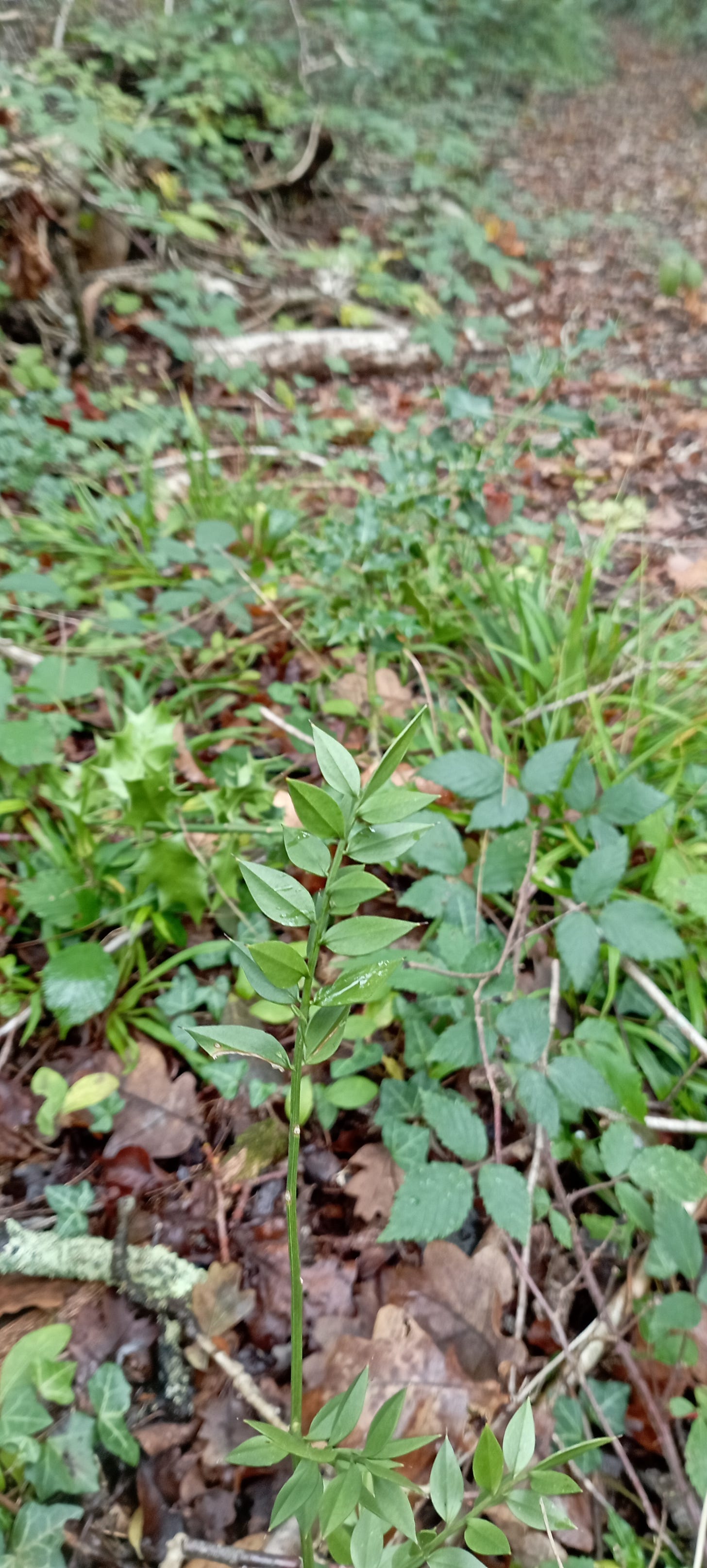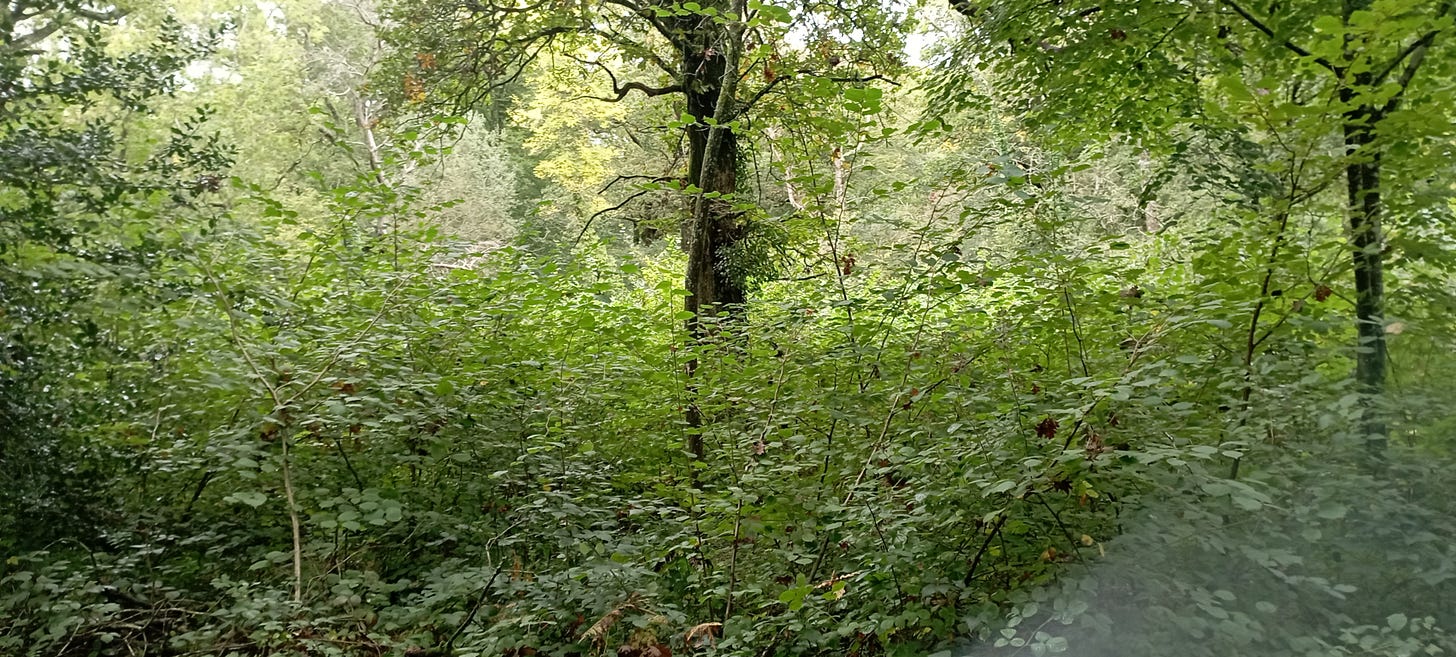New Forest Writer in Residence: October in Hartford Wood
Understory, Mosaic Habitats and the Forest Floor
This residency is hosted by the Countryside Education Trust in Beaulieu, supported by Artfulscribe and funded by the New Forest National Park Authority’s Sustainable Communities Fund.
MOSAIC: a pattern or picture made using many small pieces of coloured stone or glass
MOSAIC HABITAT: an area or site comprised of multiple habitat types
One of the words that I come across frequently in writing about New Forest habitat is the word mosaic. While I’ve often thought about the New Forest as a patchwork of heathland, woodland and coastal landscapes, the concept of a mosaic habitat is even more intricate. I imagine individual tiles, made up of ponds, grassland, streams, woodland, heath and bog, all placed together to create a mosaic image - the varied habitat of the New Forest.
Mosaic habitat is a widely-used term in conservation. It’s something that you can actually survey, identifying how all the pieces of the mosaic fit together to create an ecologically valuable landscape.
When thinking about the New Forest, I think we’re naturally inclined to picture the bigger pieces of the patchwork - especially the woodlands that we group together with names like ancient woodland or conifer plantation instead of the smaller mosaic pieces that constitute them.
I’ve been thinking a lot about those little pieces this week while exploring a patch of ancient woodland in the South East of the New Forest.
Hartford Wood, on the Beaulieu Estate, is managed by the Countryside Education Trust. As far as we know, it’s is the oldest recorded working woodland in the country, with records going back over 900 years. This is where I’ll be spending the majority of my residency over the next year. (While living in my Southampton flat, rather than the cottage below, though that would be an adventure).
The Cob Cottage, Hartford Wood
When I visit a new location as a writer, I’m often told that it is special. This might be because of wildlife or history or conservation status. Sometimes it’s a newly acquired nature reserve that few people have visited, or a location with an extraordinary history. It might be that the site provides a valuable resource to community project or a vulnerable group. There’s no doubt that they’re all incredible places - but because I’m the sort of person who thinks that almost everywhere is interesting or valuable - and has a story to tell - the word special doesn’t always hold much meaning for me. Everywhere is special for its own reasons.
But the end of my first proper day in Hartford Wood, I was actually surprised at how much I felt like I wanted to tell other people that this place was, indeed, special.
Because it was a tile of mosaic I hadn’t encountered in the New Forest before - one where the Forest Floor is more alive than anywhere else - and where the Understory is dense and varied.
Beech and oak leaves, moss, greenish clay in the North of the New Forest
FOREST FLOOR: the ground beneath the trees of a forest, consisting of roots, soil, and decomposing organic matter
UNDERSTORY: a layer of plants and bushes that grows under the canopy of a forest
For context, I’ve ambled around quite a lot of the New Forest - as a resident, a visitor, a conservation worker, a writer; usually on my own but sometimes with experts. I’m a slow walker, because I can often be found looking down at what’s beneath my feet, stopping to look at the tiny details of lichen or fungi or moss, or the leaves that have fallen.
I’ll leave aside the open heathland and wetland habitats and focus on woodland today - because even within woodlands, the mosaic of habitats in the New Forest are extensive.
You can see the change in the Forest floor wherever you walk. Acorns and beechnuts and the dense brown humus of fallen leaves give way to patches of spiky leaves beneath clusters of pollarded holly. In more undisturbed spots, the fungi emerge from the leaf-litter and deadwood: purple, veiled, lucid orange or strangely white - sometimes identified first by their scent.
Elsewhere, the floor of conifer plantations changes from mossy green to needle-spiked or swathed in tough yellow grasses as high as your knees and laced with cobwebs. In places, the tracks of forestry machinery have left established ponds or boggy patches - elsewhere the clay is drier, mounded - home to badger setts. Sometimes the plantations are carpeted in bracken for miles at a time, green and taller than a pony in summer; bronze in autumn.
Deciduous woodland near Telegraph Hill, Bracken
In other places, rhododendron is the only understory, shading out the forest floor where nothing grows. Cross the open heath and follow the sphagnum moss to the bottom of a slope and you’ll find patches of alder carr, where roots sink into the peaty water. Willow changes to crab apple and silver birch, scattered with golden leaves and fruit. Silver birch gives way to myrtle and gorse and trees on the crown of the hills, and we’re back to the ancient woodlands again, intersected with hints of long-ago coppiced hazel or overgrown beech hedges scattering the ground with beechnuts. And in places, fallen leaves remind us of the trees we are less familiar with nowadays - whitebeam and hornbeam, wayfaring tree, guelder rose, purging buckthorn, elm. Sometimes, you’ll even find neglected fruit trees from a long-untended orchard.
There’s a common thread to the places I’ve described. They are in themselves distinct patches - often uniform enough to identify them as distinct habitats - filled with the same type of leaf or grass. In many places, the floor of the forest is the most visible aspect: acorns, leaves, beechnuts. In others, the understory is uniform - with bracken or holly or rhododendron - or hazel in managed woodland like Pondhead.
It might seem ungracious to describe these locations as uniform, given that the majority of UK countryside is much less diverse, but it’s only by highlighting them in this way that I can really describe how Hartford Wood is different.
It’s mid-October, but even on a grey afternoon, the woodland feels very much alive. Good growing conditions this year have led to a second flush of leaves across the trees and undergrowth. Having only previously visited in winter, it takes me a moment to realise what is different about this woodland.
Hazel Coppice Coupe, Hartford Wood
I’m in a clearer section - a coppiced area (known as a coupe). Even though this area was cut to the ground last winter, ivy and honeysuckle have already appeared among the scattered deadwood. It wouldn’t surprise me if they kept on all winter, reaching after the light and something to hold onto. Moving further into the woods, I reach the dense undergrowth. Looking a little closer, I immediately encounter two types of orb-weaver - including Cyclosa conica, a spider that is particularly fond of dense woodland (and also pretends to be a dead fly in its own web). I can’t move for tripping over different saplings and plants.
Cyclosa conica
Then I realise. The understory in Hartford Wood is unlike any understory I’ve encountered elsewhere in the Forest - even in other patches of ancient woodland or hazel coppice.
There are hundreds of saplings and shoots of all different kinds here, from yew trees three inches high, to ivy strands and twists of freestanding honeysuckle searching for something to climb. There are ash saplings everywhere, with their buds like tiny dark deer feet. There are plants that tell us we are in ancient woodland - the rosettes of wood spurge, the deep green spikes of broom. There are ferns, still green, and bracken, turning golden brown. There is no dominant species here. Everything is clustered together, clambering or climbing over its neighbour, vying for light and space. In places, it reminds me of the varied understory you’d find in tropical rainforest.
Signs of an Ancient Woodland - Butcher’s Broom Ruscus aculeatus
Oddly, the only place I remember seeing quite so many saplings is in a section of suburban woodland, where tiny elms and beeches and oaks grow undisturbed by deer, as the woodland is surrounded by gardens and roads.
A little way on, I pass by a hazel coppice that I helped to cut in the winter of 2020. It has regrown into a sea of green taller than me. Pondhead Enclosure shares this haze of green - also helped by the fact it’s fenced to prevent deer (and horses and cattle) from munching the regrowth.
Coppiced Hazel Understory, with several years of growth
The strange thing is that according to Anna Barnard (Deputy Chief Executive at the CET, and incidentally is the first woman written into the 900 years of records of Hartford Wood) deer did visit the woodland until it was very recently fenced. So how, in comparison to the rest of the New Forest, is the understory here so rich?
Do the local deer simply prefer to graze elsewhere? Do they have a centuries long memory of being chased out of this woodland or hunted, and avoid it? Is the culling programme at this end of the forest more effective than that in the North?
Or does it have nothing to do with deer* or grazing?
My aim, throughout the year, is to understand this woodland on a deeper level. On closer inspection, the mosaic of habitats becomes a finer mosaic of species - and I start to wonder who else inhabits the woods - who else can add their tile to the image. The undergrowth makes me wonder about woodland-loving bats, like Barbastelles and Bechsteins. There must be moths and nesting birds - and I’m also told that there are woodland-dwelling hares here, too - a species I usually associate with open farmland or hedgerow margins. Without a doubt - there is a lot to discover in this small woodland.
Dr Craig Jordan-Baker, Me, and Emma Jones
Alongside my work on this residency, two other writers have been commissioned to develop pieces inspired by the New Forest and the Countryside Education Trust in particular - Emma Jones and Dr Craig Jordan-Baker. Last week, we all met together to talk about our projects - which, combined with my exploration of the woodland, was an inspiring way to kick of the residency properly. We spent two days getting to know the site, and each other, better - reflecting particularly on how we’d all come to nature writing and our approaches to it. We found a common threads in our respective interests in river writing, in discussions of the climate crisis, in our connections with Southampton and urban nature. We drifter through discussions about academia, our creative processes and favourite texts, the privileges of being able to explore nature alone; of living itinerantly and considering inequalities in access to nature - both physically and in the vocabulary that is used in ecology and conservation.
Emma Jones will be writing about species in the Beaulieu River - and Dr Craig Jordan-Baker is examining pannage (and was able to witness a pig eating roadkill squirrel, something that I’ve not seen myself but am not surprised by!)
Craig is also on Substack Nettle and Vine and on Instagram here ; Emma has recently joined Instagram here and I just found this lovely piece about Lobsters she wrote for Tiny Molecules here - her website, with the rest of her essays is here
I’m going to attempt to write a few shorter blog entries - but at the moment I’m really enjoying exploring my wider ideas about the Forest alongside some of the more impromptu descriptions of place and seeing where those ideas take me. My main aim at this stage is to collect experiences of the Forest - and of Hartford Wood in particular -whether that’s first hand from my own walks, or through running workshops with others, or through speaking to people who’ve worked in Hartford Wood and have a strong connection to the place - some of which will stay as scraps and thoughts, while others end up transformed into poetry at a later date.
If you’d like to stay posted on what’s going on throughout the year - do subscribe to this blog to have it appear in your inbox.
I’m also running an event in Hartford Wood for Children and Young People during half-term - an opportunity to explore the woodland (which is not open to the public) and find inspiration for creative writing.
Click Here for More Information and to Book
Thanks for reading - I’ll be back next month with another blog about my days in the woods!
* A note on deer: When I’ve done deer impact surveys in other parts of the Forest, their presence is far more noticeable. There are visible prints, snipped undergrowth, nibbled twigs. It’s hard to move around some parts of the woodland without seeing the white flick of a tail or the sudden panicked footfall. And now and again, you’ll stray into a well-trodden haunt that smells of musk, crowded with muddy footprints turned over in a night of rest. Hartford Wood does not feel like this.

